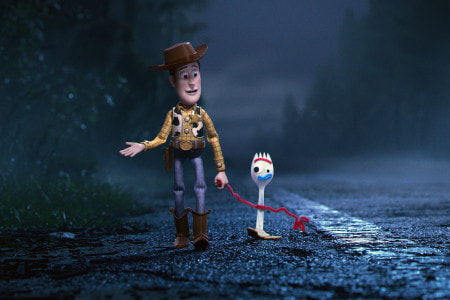Forky is Toy Story 4’s most singular creation, but the rest of the film proceeds with him as a prop or MacGuffin. Bonnie’s family is off on a vacation shortly after Forky’s, uh, birth, and what follows is a series of mishaps and pseudo-heists as he keeps throwing himself out the window with Woody in hot pursuit. Much of this takes place in a kitschy mountain town, home to a carnival and a quaint main street, that, as foreshadowed by an introductory disappearance from Andy’s house, serves as the reunion between Woody and the long-missing Bo Peep (Annie Potts). Now an independent toy who speeds around the town in a remote control car, rescuing lost toys, Bo provides Woody with a new way to live; childless but in service to children. For Woody, a toy’s purpose is to be a security blanket for a kid, and that purpose becomes a security blanket for the toy itself. The more relaxed Bo insists that kids generally will be fine even if they lose a toy now and then, which to Woody sounds like a complete abdication of responsibility. Their argument supplants Forky as the thrust of Toy Story 4 and roots Woody as the center of the world, no matter what craziness is happening in the margins.
Because Woody is separated from the regular cast of characters for most of the film, mainstays like Ham and Rex are downgraded in favor of new toys found in the mountain town. The antagonist, as much as there is one, is a doll languishing in an antique shop who kidnaps Forky in exchange for something of Woody’s. Dolly (Christina Hendricks) lords over a gang of equally-unwanted ventriloquist dummies, all of which provide the film with the scares previously supplied by disfigured baby dolls. Bo recruits allies to Woody’s cause, the most notable of which is daredevil action figure Duke Caboom (Keanu Reeves), a Canadian toy traumatized by his relationship with his boy Rejean, said in the Frenchest way possible by a game Reeves. They also run into Ducky and Bunny (Keegan Michael Key and Jordan Peele), a pair of carnival prizes who imagine themselves reenacting horror movies. If a fan of the franchise feels like they didn’t get enough time with the Potato-Heads, these new additions, plus Forky and the chemistry between Woody and Bo, salves that wound.
Something Toy Story repeatedly taps into is how resourceful its toy characters are, like being the subject of imaginative play infuses them with the imagination required to solve problems. All of the franchise entries have involved an escape or an elaborate theft, and Toy Story 4 continues in this vein. Setting aside the coincidence of stopping in the same town that Bo’s set up shop in, everything else that occurs on the film’s action front feels rooted in some earlier mechanic. In solving problem after problem, Cooley and his team of seven other writers keep things inventive but not inorganic or unbelievable. Of course, the emotional beats in a Pixar film with this kind of legacy hit home, both in the grander moments of the climax and in small moments that could only exist in this world.
As far as that finale is concerned, for this viewer, it outstrips the earlier franchise capper in Toy Story 3, potent as it is. The reflexive reaction was stronger in Toy Story 4, for reasons that would qualify as a spoiler. The ending itself justifies the film that contains it, marking Toy Story 4 as a delightful and fulfilling work in its own right, if not necessary because what third sequel ever is. If the franchise returns, there will hopefully be some Herzogian notes about the horror intimated by the series. The guy’s been known to do voice work, so who better to contemplate the never-ending misery of being stuck in an attic crate for years on end? B

 RSS Feed
RSS Feed